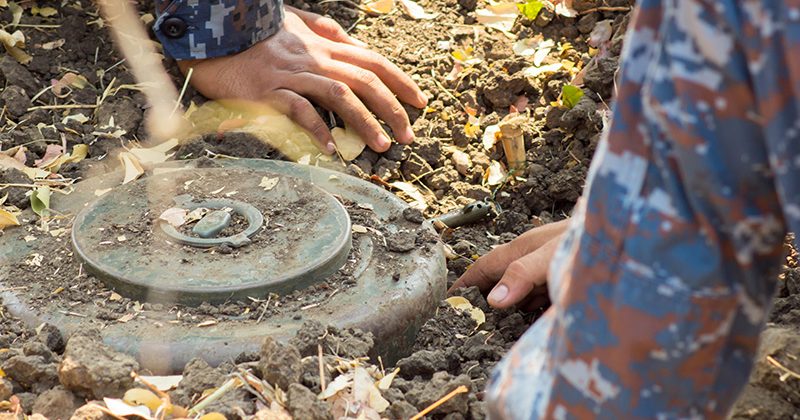Landmines and explosive remnants of war endanger lives and livelihoods, providing both humanitarian and development challenges.
The UK Global Mine Action 2 programme (GMAP2) cleared and made safe almost five hundred million square metres of land, and taught more than four million people how to stay safe around contaminated land across 14 countries.
GMAP2 had three core objectives:
- To clear and release contaminated or suspected contaminated land
- To carry out Explosive Ordnance Risk Education (EORE)
- To build the capacity of partner countries to manage their national Mine Action programmes.
Over four years, we supported these objectives by:
- Providing insights into the programme’s performance and recommendations on how to achieve the greatest possible positive impact.
- Providing independent monitoring of the performance of the partners implementing GMAP, as well as guidance on strengthening monitoring systems so as to better evidence mine action’s results.
- Conducting research to build the evidence base to inform mine action programming, including by utilising new technologies to explore how they could assist the global mine action sector to produce better evidence of its impact
- Developing a sector-wide theory of change which is now being piloted by mine action operators in six countries, supported by Itad and with funding from the Dutch government
Our role, methods and approaches
Our support to the GMAP2 programme consisted of three components; monitoring support, formative and summative evaluations, and a research project examining the wider mine action sector’s impact.
Monitoring support.
We independently monitored the performance of the partners implementing GMAP2. We also provided guidance on strengthening monitoring systems across the programme and wider mine action sector.
We aimed to ensure the programme objectives were successfully met through continually review of all GMAP2 projects over the four-year programme. This included strengthening the capacity of those implementing the projects to monitor and report on the outcomes of the work they were doing and results they achieved.
Read our blog on maximising the value of third party monitoring.
As part of this, we developed a sector-wide Theory of Change (ToC) to support better coordination between mine action stakeholders and improved, collaborative approaches to data collection.
Evaluations.
We conducted both formative and summative evaluations of the programme to assess:
- the degree to which the programme has been able to deliver on its objectives,
- the relevance of those objectives to the interests of the UK, its international partners and national stakeholders, and
- whether the programme’s results ultimately represent good value for money.
The evaluations were intended to show the UK Foreign Commonwealth and Development Office (FCDO) how the programme was performing.
They also aimed to provide recommendations on how to enhance the design of GMAP2 and future mine action programmes to maximise impact and support global learning.
We provided key recommendations on:
- how to create a better environment for national ownership of mine action,
- how to further enhance monitoring, evaluation and learning systems at country level, and
- on supporting mine action to engage in fragile and conflict-affected contexts to not only ‘do no harm’ but maximise its positive impact on conflict dynamics.
Research
We also explored the wider mine action sector’s contribution to the impact of development and stabilisation efforts in fragile and conflict-affected contexts.
During our initial literature review, we found that, whilst it is commonly assumed mine action can contribute to a range of development and stabilisation outcomes, the evidence base supporting these assumptions is limited.
Our research project was designed to contribute to enhancing that evidence base and to stimulate sector stakeholders to gather and share their own evidence, including through demonstrating the value of innovative methods and identifying current evidence gaps.
As part of this, we hosted a series of workshops bringing together a wide cross-section of mine action stakeholders from across the globe. These focused on lessons sharing around how the mine action sector is currently contributing to stabilisation and peacebuilding outcomes, how it might enhance those contributions, and how to better evidence and understand those contributions.
Read more on our mine action learning week.
We also conducted study to test and share lessons on how new technologies involving geographic information systems and satellite imagery could help generate more evidence of the sector’s impact. It focused particularly on exploring the evidence base on the development and stabilisation outcomes of mine action in Afghanistan.
Outcomes and impact
We found that GMAP2 has made a significant positive contribution to addressing the humanitarian and development impacts of mine action. It has exceeded its targets and proved to be more than the sum of its country parts.
It has played a significant advocacy role within the sector, encouraging a greater knowledge and awareness of assumptions that underpin mine action’s success. It has also strengthened the UK’s position globally.
Over the course of the programme, we have seen significant improvements in the systems employed by GMAP2 contractors to monitor and report their results, particularly at outcome-level. We have also seen a growing commitment from across the mine action sector to enhanced evidence gathering and sharing.
Findings, lessons and recommendations from our evaluations were used to inform ongoing design and implementation GMAP2 and are informing design and planning for future UK mine action programming.
Our research study has also enhanced our understanding of how mine action can contribute to development and stabilisation outcomes.
Our sector-wide theory of change has now been launched for the mine action sector to own and implement. There are encouraging early signs that this ownership will happen, and we are already seeing mine action actors such as the FCDO and UNDP making use of the theory of change to inform the design of their mine action programmes.


